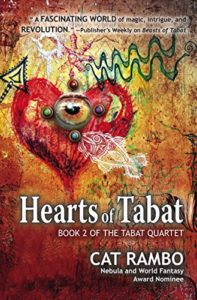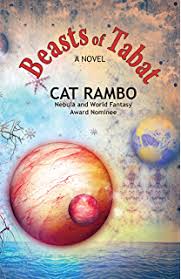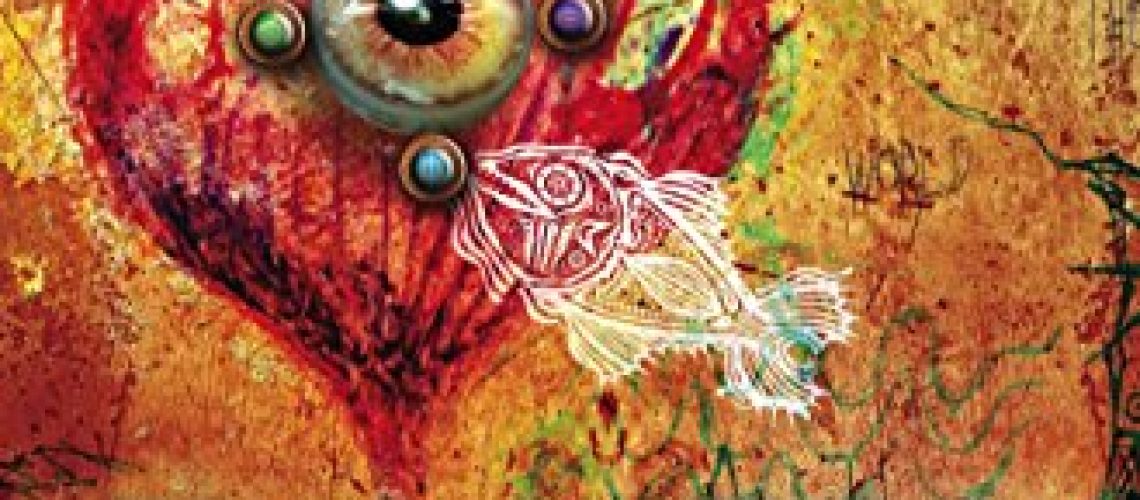Cat Rambo’s name should be a familiar one to any SF and Fantasy fans reading short fiction. Beyond publishing fiction in numerous premier outlets she also co-edited Fantasy Magazine (until its merger with Lightspeed) and served as President of the Science Fiction Writers of America. For me, Rambo’s stories fell into that category where I’d come across her name in a table of contents with pleased familiarity, but not that excited anticipation of a story that I would all but be guaranteed to love. Though always admiring her talented writing, I tend to connect with, and appreciate, her stories through a spectrum that runs from adoration to unaffected.

I therefore noted the 2015 publication of her debut novel, Beasts of Tabat, with marked interest but no particular expectations. I also hoped the fantasy would help introduce her to that broader audience who only consumes novels. Eventually I bought my copy, but it stayed in a pile of potential reads until this year, when she published Hearts of Tabat as the second in her planned Tabat Quartet.
One particularity of my reading is that I insist on reading books of a series in publication order. I’m reluctant to ever start in on things part way through, even if only book two. The first two novels of Rambo’s Tabat Quartet have shown me what could have been the first exception to that rule. To new readers I believe they actually could be read in either order, though for reasons discussed later, I might give slight preference to reading Hearts of Tabat first. Regardless which is read first, I strongly recommend that fantasy lovers check this series out.
Rather than being categorized as Books 1 and 2 of the Tabat Quartet, Beasts of Tabat and Hearts of Tabat would be more accurately dubbed Books 1 and I. Predominantly occurring within the same time frame, the plots relate a shared story told from the unique points of view of distinct characters. They are both two sides to the same start of a tale; calling them 1a and 1b would also falsely imply some inherent rationale for their publication order. Hence, I would consider both ‘one’: 1 and I, Arabic and Latin, separately equal.
Before going into the characters of either novel it’s best to first introduce the coastal city of Tabat, because it represents the true protagonist of the series. Readers with an appreciation for richly textured, world-building fantasy are in for a treat because Rambo excels at constructing Tabat with all of its magical, steampunk cultural backdrops. This ‘world’ of Tabat did not begin with the novels. Readers of Rambo’s short fiction have likely already encountered stories set there, such as “I’ll Gnaw Your Bones, the Manticore Said” published in Clarkesworld. (A complete list including pieces of flash fiction and background on her development of Tabat can be found on Rambo’s website.)
As a port, the densely populated seat of a duchy, and the host to popular gladiatorial combats played in proxy to magically drive the passage of seasons, the city of Tabat is a chaotic bustle of pleasure, opportunity, danger, and oppression. The sociopolitical order of Tabat and its people is built upon a classism stemming largely from an ancient accord forged after a horrific, continent-destroying war that is now mostly forgotten. At the bottom of the social hierarchy are the Beasts, magical creatures that exist alongside humans, but are denied all human rights. Despite their consciousness and intelligence they are treated as animals, property kept in a slavery of labor and soul that underlies the economy and culture of Tabat. But, small seeds of rebellion against this status quo have begun to set the city (and some of its established and newly arrived citizens alike), onto a path of slowly building instability, and eventual turmoil.

Beasts of Tabat introduced readers to two main point-of-view characters. The first is Teo, a young boy from the country who is sold by his parents to Temple priests in Tabat. However, upon arriving Teo takes advantage of a chance opportunity to escape into a life on the streets. There, Teo struggles to survive while hiding his identity both as a child promised to the Temple and as being part Shifter, a feared race killed on sight in Tabat. The second character is Bella Kanto, Tabat’s most famous gladiator, who enjoys the patronage and support of Tabat’s Duke, and who stars as the heroine of penny-wise books that have captivated Teo for years. Soon the two become linked in plots seeking greater rights for Beasts and upending the established order of the city. The novel ends just as things are coming to head, ending in cliffhangers for both Teo and Bella.
Hearts of Tabat resets back to roughly the time when Beasts of Tabat also began, but this time relates the same period of the city’s history from the point of view of characters that appeared as minor characters in the first published books. As the focus makes these the major characters, Teo and Bella retreat into the background as readers now get scenes that featured both sets of protagonists from a different viewpoint than they had in Beasts of Tabat. Adelina Nettlepurse is a young woman from a wealthy family who is the secret owner of a book press. But Adelina’s mother is pressuring Adelina to move on from a dalliance with Bella Kanto to find a suitable match for marriage that could aid in a political career. Complicating these plans, Adelina finds her attraction torn between Eloquence, a ship captain below her social standing, and Merchant Mage Sebastiano Silvercloth, a man with a fondness for/connection with Beasts. When a manuscript with a dangerously subversive message winds up in Adelina’s hands as editor of her press, she is drawn with the others into turmoil that engulfs Tabat as related in Beasts of Tabat. Thus Hearts of Tabat also ends around the same time point, with similar cliffhangers to set up the third and fourth book of the Tabat Quartet collectively.
Some readers have been bothered by the parallel organization of the first two Tabat Quartet books. Generally, the issue seems to be that some don’t like investing in major characters up to a cliffhanger only to then get the next installment and find that they must still wait for a resolution to their stories. I hadn’t realized this organization going into the books, and I was not bothered by it at all. I imagine that simply knowing the structure in advance would make it easier for most readers too. I don’t find anything inherently bad in Rambo writing her books this way, in fact I find it interesting, probably similar to how she thought it would be an interesting way to tell the story of Tabat and its Beasts, from multiple interlocking points of human views.
Nonetheless, I do think that these two books can be better appreciated separately in combination than separately in isolation. In other words, these novels would not work if meshed into one big, single text. It would be too much, and there would be subtle unfortunate clashes between characters and themes between the two volumes. It also would reduce the joy of seeing scenes or series of events through separate eyes. But, they also can’t be appreciated fully on their own, having impact bigger than the sum of their parts.
Upon finishing Beasts of Tabat I considered it good, but not great. It left me still intrigued in the world, but feeling as if it hadn’t gone deep enough into the themes of Beast slavery and oppression. This felt more of a loss to me than the incomplete character arcs of Bella and Teo. Things had just gotten particularly interesting, and it ended. The lead-up introduced me to the world and characters, but it hadn’t been as entertaining as the end. I found myself more interested in knowing more about some secondary characters rather than the leads.
By Hearts of Tabat there was no such lag period. I knew the world. I knew the events that were coming. So I just enjoyed the ride from beginning to end, and I adored Hearts of Tabat. The second book may not have gotten any more deeply into the themes of Beast oppression or the history of the Tabat ‘world’. But it certainly did expand these without going through pages as a stranger to the setting. I therefore wonder if I had read this one first and Beasts of Tabat second, would my feelings for the two volumes simply be flipped?
The characters represent the one element that leads me to conclude that the answer to that might be no. Relative to the major characters of Hearts of Tabat, I found Teo and Bella to be less compelling. As an innocent country boy in the city, an heir of magical powers and a possible destiny beyond what he realizes, Teo is a rather standard genre archetype, and one that I personally am not eager to see another take on. Bella on the other hand has a grating personality, mostly comprised of combined arrogance and obliviousness. On the plus side, I expect that personality will change at least some given her circumstances by the end of the novels.
Hearts of Tabat may also feature archetype characters, but these are ones I became more invested in, independently of when I ‘met’ them as a reader. Adelina is a wonderfully written complex character going through difficult decisions of politics and love while also reaching independent adulthood. The romantic sides of the novel add a great dimension to the story that Beasts of Tabat lacked, and allowed further connection between the major characters of this book that weren’t possible in the separation of Bella and Teo on multiple levels. The two suitors in the love triangle with Adelina are in some ways the male equivalents of Bella. (Not surprising I guess since Adelina was also in a romantic relationship – and now just friendship – with Bella.)
Both Sebastiano and Eloquence have their share of that dangerous combination: arrogance and ignorance. The difference for me is that this was tempered with other aspects of their lives and personalities that I found engaging, while Bella had only her commitment to the Gladiator fights and her history of numerous relationships to round out her character. The relationship between Sebastiano and the Beasts, morally imperfect yet still heartfelt and built upon compassion and unacknowledged realization that they also have ‘humanity’ and worth, is intriguing. Similarly the conflicts that devout religion bring to Eloquence and his family in the face of events and other emotions and beliefs they hold made the second novel all the more fascinating to me.
Ultimately I suspect that the connection with each novel will depend on personal factors and the order in which they are read. One argument for reading the publication order with Beasts of Tabat first is that volume does give more information regarding the reason for the events of turmoil that erupt at the close of this time line. If starting with Hearts of Tabat, the mystery of why things are occurring might bug some.
So start with one, or start with the other. As Rambo is experimenting with the structure, readers have to experiment with it too and see what works. But I think most will find something to connect with in one of the two volumes or the other, and ultimately make this a very satisfying series to read, with a fantasy world laid out in a beautiful tapestry of timely, meaningful themes.







